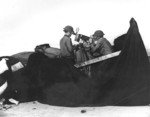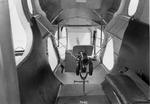Browning M1919 Machine Gun
| Country of Origin | United States |
| Type | Machine Gun |
| Caliber | 7.620 mm |
| Capacity | 250 rounds |
| Length | 1.219 m |
| Barrel Length | 609.000 mm |
| Weight | 14.000 kg |
| Rate of Fire | 500 rounds/min |
| Range | 1.370 km |
Contributor: C. Peter Chen
ww2dbaseBrowning M1919 medium machine guns were developed directly from the Browning M1917 medium machine gun design, one major difference being that the M1917 used water for cooling, while the M1919 design was air-cooled. A typical crew had the size of two. During combat, the first member acted as the gunner while the second fed ammunition belts; at other times, the gunner carried the tripod and ammunition, while the other crew member carried the gun and sometimes additional ammunition.They were made by various manufacturers during WW2, including General Motors in the United States, Rock Island Arsenal of the US Army, and Birmingham Small Arms Company in the United Kingdom. There were a number of variants, and M1919A4 and M1919A4E1 were the most numerous, one reason being that they were also capable of being mounted on vehicles. During WW2, many tanks mounted M1919 machine guns as secondary armament, for example.
A particular variant design made by Browning, designated "Browning Machine Gun, Cal. .30, M2, Aircraft", was envisioned with aircraft in mind. Because of the air rushing past barrels when the aircraft were in flight, M2 machine guns mounted on them did not require as efficient a cooling system, therefore the barrel and receiver diameters were significantly reduced, resulting in guns that were significantly lighter than their M1919 cousins. M2 machine guns were seen on the Spitfire fighters in early stages of the European War until the larger caliber Hispano-Suiza HS.404 cannon were introduced. This variant should not be confused with the larger caliber "Browning Machine Gun, Cal. .50, M2, Aircraft", also known as the Browning M2HB heavy machine guns, which was of a totally different design.
Source: Wikipedia. ww2dbase
Last Major Revision: Dec 2007
Browning M1919 Machine Gun Interactive Map
Photographs
 |  |
Please consider supporting us on Patreon. Even $1 per month will go a long way! Thank you. Please help us spread the word: Stay updated with WW2DB: |
Visitor Submitted Comments
2.  Bill says:
Bill says:
10 Apr 2010 07:33:42 PM
The M1919A4 was the standard crew-served light-machine gun, for the U.S.Army during
WWII.
About 439,000 weapons were produced during
WWII each rifle company had three rifle
platoons, and one weapons platoon with a
light machine gun section.
What is a crew-served weapon?
1. Gunner
2. Assistant Gunner
3. Ammunition Carriers
4. Squad Leader
What do they do?
1. Gunner: aimed and fired the weapon, on the
move, he also carried the tripod, plus extra ammunition.
2. Assistant Gunner: Fed and reloaded ammunition and carried the weapon, its spare
parts kit when the section was on the move.
3. Ammunition Carriers: Carried extra ammo
also additional men in the company,were used
to carry ammunition as well. The ammunition
came in 250 round ammo boxes.
4. Squad Leader: His job was to pick out the
best field of fire, prepare the position.
Machine gun crews covered the flanks to
prevent the enemy from attacking behined.
Ammunition: The M-1919A4 fired .30 caliber/
7.62mm ammunition, the same as used in the M-1 Grand rifle.
What are short bursts?
Gunners were trained to fire the weapon in
short bursts, to avoid the barrel from overheating. But in battle gunners pushed the
weapon to it full rate of fire: 400 to 600
rounds per minute.
Sixty rounds per minute one round per second.
One hundred rounds per minute two rounds per second.
Six hundred rounds per minute ten rounds
per second.
In 1966 the U.S. Army still used the M1919
for training, and I was able to fire this
weapon, at Artillery School, Ft. Sill, OK.
10 Apr 2010 07:33:42 PM
The M1919A4 was the standard crew-served light-machine gun, for the U.S.Army during
WWII.
About 439,000 weapons were produced during
WWII each rifle company had three rifle
platoons, and one weapons platoon with a
light machine gun section.
What is a crew-served weapon?
1. Gunner
2. Assistant Gunner
3. Ammunition Carriers
4. Squad Leader
What do they do?
1. Gunner: aimed and fired the weapon, on the
move, he also carried the tripod, plus extra ammunition.
2. Assistant Gunner: Fed and reloaded ammunition and carried the weapon, its spare
parts kit when the section was on the move.
3. Ammunition Carriers: Carried extra ammo
also additional men in the company,were used
to carry ammunition as well. The ammunition
came in 250 round ammo boxes.
4. Squad Leader: His job was to pick out the
best field of fire, prepare the position.
Machine gun crews covered the flanks to
prevent the enemy from attacking behined.
Ammunition: The M-1919A4 fired .30 caliber/
7.62mm ammunition, the same as used in the M-1 Grand rifle.
What are short bursts?
Gunners were trained to fire the weapon in
short bursts, to avoid the barrel from overheating. But in battle gunners pushed the
weapon to it full rate of fire: 400 to 600
rounds per minute.
Sixty rounds per minute one round per second.
One hundred rounds per minute two rounds per second.
Six hundred rounds per minute ten rounds
per second.
In 1966 the U.S. Army still used the M1919
for training, and I was able to fire this
weapon, at Artillery School, Ft. Sill, OK.
3. Anonymous says:
22 Sep 2012 04:43:13 PM
There were two M1919 light machine guns in each U.S. standard Infantry Company.
22 Sep 2012 04:43:13 PM
There were two M1919 light machine guns in each U.S. standard Infantry Company.
4. Anonymous says:
1 Jan 2014 08:09:53 PM
I FOUND A WORKING M1919 MG HERE IN THE DOMINCAN REP.
1 Jan 2014 08:09:53 PM
I FOUND A WORKING M1919 MG HERE IN THE DOMINCAN REP.
5. Anonymous says:
3 Nov 2016 10:52:26 AM
doing a ww2 project on their weapons this is very helpful
3 Nov 2016 10:52:26 AM
doing a ww2 project on their weapons this is very helpful
6. Anonymous says:
23 Mar 2021 08:18:35 AM
For some reason I thought this chambered in 50
23 Mar 2021 08:18:35 AM
For some reason I thought this chambered in 50
7.  Alan Chanter says:
Alan Chanter says:
31 Jul 2021 09:26:28 AM
The air-cooled, U.S. and British AN/M2 aircraft machine gun was significantly lighter than the M1919A4 from which it was derived, with a markedly higher rate of fire (1200-1500rpm. (AN indicated ‘Army/Navy’ as the gun was developed jointly for use by both services). This 7.62mm (0.3in) machine gun armed many of the US aircraft supplied to Russia. A similar Browning 7.7mm (0.303in), based on the 1930 pattern belt-fed Colt-Browning machine gun, was adopted by the RAF as the Browning .303 Mk II in the 1930s in hydraulic operated and hand-fired form (for fighters and bombers respectively). This weapon, licence-built by Vickers Armstrong and BSA, armed most of the Lend-Lease aircraft supplied from the USA.
31 Jul 2021 09:26:28 AM
The air-cooled, U.S. and British AN/M2 aircraft machine gun was significantly lighter than the M1919A4 from which it was derived, with a markedly higher rate of fire (1200-1500rpm. (AN indicated ‘Army/Navy’ as the gun was developed jointly for use by both services). This 7.62mm (0.3in) machine gun armed many of the US aircraft supplied to Russia. A similar Browning 7.7mm (0.303in), based on the 1930 pattern belt-fed Colt-Browning machine gun, was adopted by the RAF as the Browning .303 Mk II in the 1930s in hydraulic operated and hand-fired form (for fighters and bombers respectively). This weapon, licence-built by Vickers Armstrong and BSA, armed most of the Lend-Lease aircraft supplied from the USA.
8.  Alan Chanter says:
Alan Chanter says:
1 Aug 2021 12:33:08 AM
In order to utilise British ammunition, a number of US Lend-Lease aircraft supplied to the RAF and other Commonwealth Air Forces were re-armed with a gun (licence-built by Vickers Armstrong and BSA) similar to the American 7.62mm AN/M2 but with a calibre of 7.7mm (0.303). Based on the 1930 pattern belt-fed Colt-Browning machine gun this weapon was adopted by the RAF as the Browning .303 Mk II in the 1930s and came in either hydraulically operated or hand-fired form (for fighters and bombers respectively). Aircraft shipped to the Soviet Union however retained the US 7.62mm calibre weapon as this was the same calibre as that used by Red Army machine guns.
1 Aug 2021 12:33:08 AM
In order to utilise British ammunition, a number of US Lend-Lease aircraft supplied to the RAF and other Commonwealth Air Forces were re-armed with a gun (licence-built by Vickers Armstrong and BSA) similar to the American 7.62mm AN/M2 but with a calibre of 7.7mm (0.303). Based on the 1930 pattern belt-fed Colt-Browning machine gun this weapon was adopted by the RAF as the Browning .303 Mk II in the 1930s and came in either hydraulically operated or hand-fired form (for fighters and bombers respectively). Aircraft shipped to the Soviet Union however retained the US 7.62mm calibre weapon as this was the same calibre as that used by Red Army machine guns.
All visitor submitted comments are opinions of those making the submissions and do not reflect views of WW2DB.
Change View
Desktop ViewSearch WW2DB
News
- » US Women's Army Corps "Six Triple Eight" Awarded with Congressional Gold Medal (30 Apr 2025)
- » Wreck of Soviet Submarine M-49 Found (10 Apr 2025)
- » Japanese Emperor Visited Iwoto (Iwo Jima) (8 Apr 2025)
- » Race, Holocaust, and African-American WW2 Histories Removed from the US Naval Academy Library (7 Apr 2025)
- » US Government Plans to Purge WW2 Information (17 Mar 2025)
- » See all news
Current Site Statistics
- » 1,167 biographies
- » 337 events
- » 44,617 timeline entries
- » 1,244 ships
- » 350 aircraft models
- » 207 vehicle models
- » 376 weapon models
- » 123 historical documents
- » 261 facilities
- » 470 book reviews
- » 28,514 photos
- » 365 maps
Famous WW2 Quote
"I have returned. By the grace of Almighty God, our forces stand again on Philippine soil."General Douglas MacArthur at Leyte, 17 Oct 1944
30 Nov 2008 05:02:59 PM
best gun eva